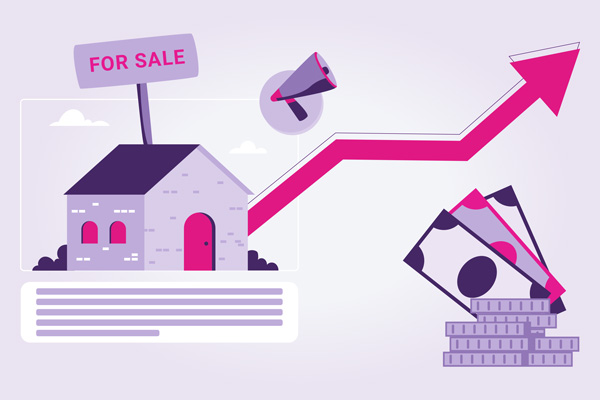
According to Rightmove, average asking prices for UK homes have soared by £55,000 since the beginning of the pandemic, with no slowdown as a result of the cost-of-living crisis that has gripped the nation.
The property website also revealed that asking prices increased by £7,400 (or 2.1%) between April and May, bringing the average to a new record high of £367,501.
What’s more, despite concerns about the health of the UK economy – with inflation at a 40-year high, interest rates increasing at a rapid rate and wage stagnation or declines in many industries – prices have grown by 10.1% in the past year alone. The property market is therefore bucking the trends seen elsewhere.
Rightmove have said that a fourth successive interest rate rise by the Bank of England (there’s now been a fifth since the research was released, as the Bank tries to keep inflation in check) has done little to reduce demand.
And it is this demand that explains why asking prices continue to rise even as people’s bank balances start to feel the pinch. Demand is continuing to massively outweigh supply, which means only one thing – an upwards pressure on house prices.
There are no signs that the supply-side issue is going to be fixed anytime soon, which could lead to asking prices rising higher still.
Rightmove’s findings help to paint the picture more vividly. It found that activity levels remain robust and substantially greater than before the pandemic. In fact, the portal said that the number of buyers is up nearly a third compared to 2019 levels.
Additionally, sales agreed have risen by 12% so far this year, in comparison to the same period in 2019, but are down 17% in the year to date compared to 2021, when the stamp duty holiday was still in force.
By contrast, the number of available properties for sale on the market is down 16% compared to last year and 55% compared to 2019. With the most acute shortages being for two and three-bedroomed semi-detached homes.
The ongoing disparity between supply and demand means it remains a sellers’ market for many, with those looking to sell their homes remaining in a strong negotiating position.
Will it last?
Tim Bannister, director of property at Rightmove, believes that rising living costs and interest rates will begin to negatively impact prices later this year.
He said: “People may be wondering why the housing market is seemingly running in the opposite direction to the wider economy at the moment. What the data is showing us right now is that those who have the ability to do so are prioritising their home and moving, and the imbalance between supply and demand is supporting rising prices.”
He added: “Though demand is softening from the heady levels we saw this time last year, the number of buyers enquiring is still significantly higher than during the last ‘normal’ market of 2019, while the number of homes for them to choose from remains more constrained.”
While both high demand and constrained supply remain in place, there is unlikely to be any major drop in asking prices.
However, there are signs that buyer demand will start to diminish, with Rightmove pointing out in its research that average monthly mortgage payments in May increased to overtake average monthly rent payments.
The research found that the average monthly mortgage payment for a typical First Time Buyer has gone up by 13% (£100) since December 2021, following successive interest rate rises. That said, this is only 11% (£87) higher than ten years ago.
What happens next?
The future is largely reliant on how buyers and sellers react to the cost-of-living crisis, which is going to remain with us for some time. The current domestic and global political uncertainty could also start to have an impact. Although, so far, the property market has batted away Covid-19 and the cost-of-living crisis much more easily than it did Brexit deadlock and the global financial crisis.
The fundamentals of the market remain sound, which makes any sudden falls in prices unlikely. Buyers may still be keen to buy before interest rates go up again, and while decent mortgage deals remain on the market. If they are First Time Buyers, they may feel that trying to get on the property ladder is a better way of shielding themselves against the rising cost of living than renting.
Sellers, meanwhile, continue to find themselves in an enviable position for the moment, but may be wary of the long-term impact of the cost-of-living crisis and may be eager to sell now before the market takes a turn for the worse.
There have already been some murmurings of a slowdown in the market, which could convince wavering sellers to act now.
Problems remain with the number of transactions that fall through each year, and the time it takes to get a sale completed, which could continue to put some sellers off.
While ever-increasing asking prices might seem like fantastic news for sellers, for a smooth and well-functioning property market, it’s not really sustainable. There is also always a danger that the bubble bursts, like it did in 2007-8, and issues like negative equity start to rear their head again.
For the moment, that seems highly unlikely, and the greater likelihood is that average asking prices will continue to go up month on month for the foreseeable future.